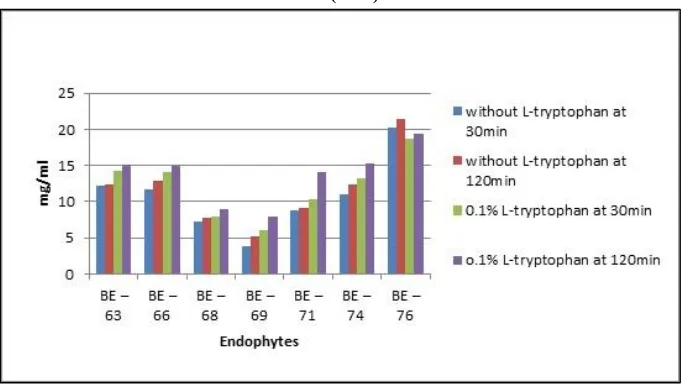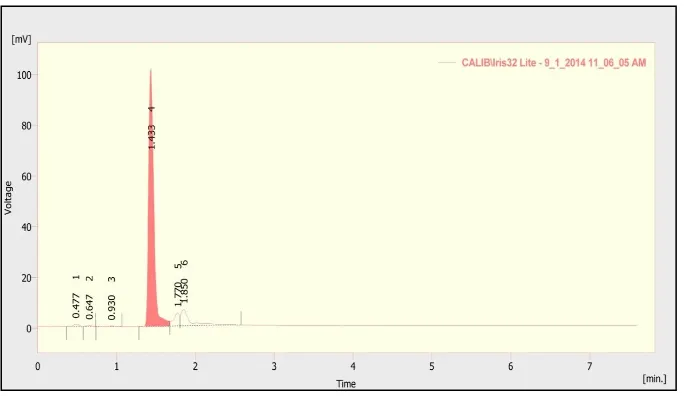Journal of Chemical and Pharmaceutical Research, 2018, 10(2):6-10
Research Article
CODEN(USA) : JCPRC5
ISSN : 0975-7384
6
Indole Acetic Acid (IAA) Production by
Bacillus siamensis
BE 76
Isolated
from
Musa balbisiana
(Banana)
Mukund S Ambawade
*and Girish R Pathade
Haribhai V Desai College, Pune, Maharashtra, India
_____________________________________________________________________________
ABSTRACT
Based on morphological, biochemical and 16s rRNA gene sequencing a newly isolated endophytic bacterium from the Musa balbisiana (banana) was identified as Bacillus siamensis and designated as BE 76. There are fifteen bacterial isolates were screened out for their productivity of Indole acetic acid by spectrophotometeric method. Out of these isolates BE-76 isolate showed high amount of Indole acetic acid production supplemented with and without L tryptophan in medium. The productivity of IAA from BE-76 isolate supplemented with and without L tryptophan in medium was confirmed by High-Performance Liquid Chromatography (22.74, 20.46 ppm, respectively at 280 nm) for more accuracy. This bacterium will further be useful for preparation of liquid bioinoculant to enhance the banana production as well as for ecofriendly and sustainable agriculture.
Keywords: Banana; Indole acetic acid; HPLC; 16s rRNA gene sequencing
_____________________________________________________________________________
INTRODUCTION
The indole acetic acid (IAA) is one of the most significant physiologically active phytohormon. IAA is a common product of L- tryptophan metabolism produced by several microorganisms including Plant Growth-Promoting Rhizobacteria (PGPR) [1]. Musa balbisiana is a species of wild banana native to eastern south Asia especially in India. It is one of the ancestors of modern cultivated bananas, along with Musa acuminata. Some PGPR belonging to genera Azoarcus, Azospirillum, Azotobacter, Arthrobacter, Bacillus, Clostridium, Enterobacter, Gluconacetobacter, Pseudomonas, and Serratia, have been reported [2]. Phytohormones (Indole acetic acid, Gibberellins) are plant growth regulators, which have stimulatory effects on plant growth and health [3]. The banana endophytic bacteria such as Stenotrophomonas Maltophilia produce Indole acetic acid [4]. IAA stimulates cell elongation by modifying certain conditions like, increase in osmotic contents of the cell, increase in permeability of water into cell, decrease in wall pressure, an increase in cell wall synthesis and inducing specific RXA and protein synthesis also. It promotes embial activity, promotes embial activity, inhibit or delay abscission of leaves, induce flowering and fruiting [5]. Indole acetic acid also helps in the production of longer roots with increased number of root hairs and root laterals which are involved in nutrient uptake in the plants [6]. The present investigation was conducted to demonstrate the Indole acetic acid production of Bacillus siamensis BE 76 isolated from stems of banana (Musa spp) and with and without L-tryptophan supplement in medium. Such bacterium is further useful for preparation of bioinoculant to enhance growth and productivity of banana as well as to decrease use of harmful chemical fertilizers.
MATERIALS AND METHODS
Isolation of Endophytic Bacterial Isolates
7
potassium phosphate buffer at pH 7. For isolation of indole acetic acid producing endophytic bacterial isolates the nitrogen-free media - NFb was used [7]. A sample was spread on NFb medium and kept for incubation for 48to72hrs at room temperature. Well isolated colonies were observed for morphological and culture characterization. Total Fifteen isolates were obtained from stems of banana plant. The isolates were further checked for IAA production.
Morphological Characterization of Isolates
Morphological characterization was done on the basis of colony size, shape, colour, margin, opacity, consistency, elevation, motility and gram staining, endospore; capsule staining and based on the colony morphotypes selection of representative isolates was done.
Biochemical Characterization of Promising Bacterial Isolate
Biochemical tests like the tests involved, oxidase, amylase and gelatinase, catalase like enzyme production, citrate utilization, indole test, Vogus Proskaur test, methyl red test, H2S production, sugars (Glucose, Sucrose, Lactose, Xylose and Mannitol) fermentation, Triple sugar iron (TSI) test, nitrate reduction, urease test etc. [8].
Genetical Characterization of Promising Endophytic Bacterial Isolates
The genomic DNA in triplicates was isolated from bacterial cells using suggested method [9].The bacterial genomic DNA was isolated by using microbial DNA geneO-spin isolation kit (geneOmbio technologies, Pune; India). The BLAST analysis was performed at BlastN site at NCBI server and similarity was checked [10].
Spectrophotometric Estimation of Indole Acetic Acid (IAA)
For the quantitative estimation of IAA produced by bacterial isolates the Salkowski’s method was used [11]. The isolates were grown in 100 mL yeast malt dextrose broth in triplicates with and without ± 0.1% L-tryptophan (Himedia, India) and incubated at room temperature (28°C) for 3 days. After incubation broth was centrifuged at 10,000 rpm for 30 min extracted as above and 2 mL methanolic extract was mixed with 1 drop of orthophosphoric acid and 4 mL of Salkowski’s reagent (50 mL, 30% perchloric acid; 1 mL 0.3 FeCl3) and kept in the dark for 120 min. The absorbance was recorded on spectrophotometer (Systronics-119) at 530 nm after 30 min and 120 min intervals.
Estimation of Indole Acetic Acid (IAA) on HPLC
The solvents used for separation of IAA and GA were water: acetonitrile [76:24 (v/v)] as a mobile phase. The solvent and sample flow rate was adjusted at 2 mL/min, with an average run time of 20 min/sample. The wavelength was used for detection of IAA as 280 nm [12].
RESULTS AND DISCUSSION
Isolation and Characterization of Endophytic Bacterial Isolates
From stems of Musa balbisiana (BB) total fifteen N2 fixing endophytic bacterial isolates were obtained. As per morphological characterization of these isolates ten isolates were gram negative rods, four were gram positive rods while one isolate was gram positive coccus in appearance. The sporulation was shown by only three gram positive isolates, capsulation by eight gram negative rods while motility by both gram positive and negative rods.
Biochemical Characterization of Promising Bacterial Isolate (Table 1)
Table 1: Biochemical characterization of gram-positive promising bacterial isolates
Sr. No. Biochemical Tests Isolates BE- 76
1 Oxidase test +
2 Amylase test +
3 Gelatinase liquification test +
4 Catalase test -
5 indole test +
6 methyl red test -
7 Vogus Proskaur test -
8 citrate utilization -
8
10 Glucose +
11 Sucrose +
12 Xylose +
13 Mannitol +
14 Lactose +
15 Triple sugar iron (TSI) test +
16 nitrate reduction +
17 Urease test -
Identification of Promising Endophytic Bacterial Isolates by Genetically (16 S-rRNA Gene Sequencing) Characterization
16s rRNA Gene Sequencing (Partial) of Isolate BE 76>3343_BE76:
GTCTGAACCGCATGGTTCAGACATAAAAGGTGGCTTCGGCTACCACTTACAGATGGACCCGCGGCGCA TTAGCTAGTTGGTGAGGTAACGGCTCACCAAGGCGACGATGCGTAGCCGACCTGAGAGGGTGATCGG CCACACTGGGACTGAGACACGGCCCAGACTCCTACGGGAGGCAGCAGTAGGGAATCTTCCGCAATGG ACGAAAGTCTGACGGAGCAACGCCGCGTGAGTGATGAAGGTTTTCGGATCGTAAAGCTCTGTTGTTAG GGAAGAACAAGTGCCGTTCAAATAGGGCGGCACCTTGACGGTACCTAACCAGAAAGCCACGGCTAAC TACGTGCCAGCAGCCGCGGTAATACGTAGGTGGCAAGCGTTGTCCGGAATTATTGGGCGTAAAGGGCT CGCAGGCGGTTTCTTAAGTCTGATGTGAAAGCCCCCGGCTCAACCGGGGAGGGTCATTGGAAACTGGG GAACTTGAGTGCAGAAGAGGAGAGTGGAATTCCACGTGTAGCGGTGAAATGCGTAGAGATGTGGAGG AACACCAGTGGCGAAGGCGACTCTCTGGTCTGTAA
After NCBI BLAST analysis these bases 99% matched 100% query with Bacillus siamensis belong the family
Bacillaceae and hence this isolate was identified as Bacillus siamensis based on Morphological, biochemical analysis and 16s rRNA gene sequencing and was designated as BE 76. Bacillus spp. also reported by[13].
[image:3.612.136.480.373.565.2]Spectrophotometric Estimation of Indole Acetic Acid (IAA)
Figure 1: Estimation of indole acetic acid (IAA)
9
[image:4.612.137.481.70.268.2]Figure 2: HPLC chromatogram of IAA produced by BE-76 isolate without L-tryptophan in medium
Figure 3: HPLC chromatogram of IAA produced by BE-76 isolate with 0.1% L- tryptophan in medium
In the present investigation great diversity with respect to IAA production was found where it ranged from as low as 3.842 ppm (BE-69) to maximum about 21.453 ppm (BE-76) and many isolates showed quite high (in between 7 to 12 ppm). IAA production ability indicating their potential for use as plant growth promoting bacteria. In the HPLC analysis of the IAA the endophytic bacterial isolate BE-76 (22.74, 20.46 ppm) produced high amount of IAA with and without L-tryptophan supplement in the medium (Figures 2 and 3). This bacterium will further be useful to preparation of liquid bioinoculant for improvement of banana health and yield. All the isolates produced more amount of IAA in the presence of tryptophan in the medium [14]. A wide range of variation existed in the IAA producing ability between the endophytic isolates. It ranged from 6 ppm to 19 ppm (with L- tryptophan) and 3 ppm to 21 ppm (without L-tryptophan). As per spectrophotometric as well as HPLC analysis in the present study BE 76 isolate produced high amount of IAA with and without L-tryptophan supplement in medium.
CONCLUSION
10
confirmed with High performance liquid chromatography (HPLC). It is concluded that presence of such growth promoting endophytic bacteria (Bacillus siamensis BE 76) will accountable for the beneficial effects on crop growth and yield. The significance of the study could be stated as the potential of these IAA producing isolate will flourish the growth and ultimately IAA production in the field and prevent environmental pollution by avoiding excessive applications of hazardous chemical fertilizers. This Indole acetic acid producing bacterium will also be helpful to development of liquid bioinoculant for economically convenient and sustainable agriculture.
ACKNOWLEDGEMENT
The authors are thankful to Haribhai V. Desai College, Vasantdada Sugar Institute and Fergusson College, Pune for their continuously support and engorgement.
REFERENCES
[1] JM Lynch. Lancaster. 1985, 151-174.
[2] T Hurek; HB Reinhold. J Biotechnol. 2003, 106, 169. [3] T Hurek; HB Reinhold. J Biotechnol. 2003, 106, 169.
[4] MS Ambawade; GR Pathade. Int J Sci Res.2015, 4(1), 2644-2650. [5] Y Zhao. Annu Rev Plant Biol. 2010, 61, 49-64.
[6] Y Zhao. Annu Rev Plant Biol. 2010, 61, 49-64.
[7] J Dobereiner; IE Marriel; M Nery. Can J Microbiol. 1976, 22, 1464-1473.
[8] JG Holt, NR Krieg, PHA Sneathl, JT Staley, ST Williams. Bergey’s Manual of Determinative Bacteriology, 9th Edition, Williams & Wilkins, Baltimore, MS, USA, 1994.
[9] G Kirchhof; M Schloter; B Aßmus. Soil Biol Biochem. 1997, 29, 853-862. [10] http://ww.ncbi.nlm.nih.gov/BLAST
[11] A Ehmann. J Chromatogr.1977, 132, 267-276.
[12] MM Sarwar; DA Arshad; Martens; WTJr Frankenberger. Plant Soil. 1992, 147, 207-215.
[13] SA Souza; AA Xavier; MR Costa; MS Acleide; Cardoso; CT Marlon; Pereira; S Nietsche. Genet Mol Biol.
2013, 36(2), 252-264.

